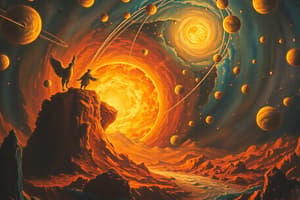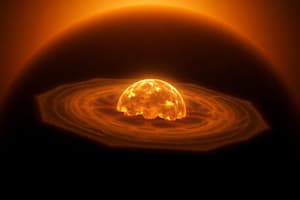Podcast
Questions and Answers
What defines a superearth?
What defines a superearth?
- A planet larger than Earth but smaller than gas giants (correct)
- A planet similar in size to gas giants
- A planet primarily composed of ice and gas
- A planet that orbits a binary star system
What does the similar orbital plane of the planets suggest about their formation?
What does the similar orbital plane of the planets suggest about their formation?
- They were formed in isolation from one another
- They originated from a spinning cloud of gas and dust (correct)
- They adhere to a gravitational pull from a central black hole
- They evolved from the collision of multiple celestial bodies
What compositional similarity exists between the Sun and gas giants like Jupiter and Saturn?
What compositional similarity exists between the Sun and gas giants like Jupiter and Saturn?
- They have a light composition with abundant ice
- They mostly contain carbon and nitrogen
- They are dominated by hydrogen (correct)
- They are mainly composed of heavy metals
Which materials are primarily found in the inner solar system?
Which materials are primarily found in the inner solar system?
What is the likely reason lighter materials are less prevalent in the inner solar system?
What is the likely reason lighter materials are less prevalent in the inner solar system?
What primarily composes the outer solar system's planets and their moons?
What primarily composes the outer solar system's planets and their moons?
How do spectroscopic analyses contribute to our understanding of planetary composition?
How do spectroscopic analyses contribute to our understanding of planetary composition?
What evidence is explored to understand the origins of the solar system?
What evidence is explored to understand the origins of the solar system?
What type of volcanic activity is associated with subduction zones?
What type of volcanic activity is associated with subduction zones?
How long has the Hawaii hot spot been active?
How long has the Hawaii hot spot been active?
What does a pressure of 1 bar indicate at sea level?
What does a pressure of 1 bar indicate at sea level?
Which of the following volcanic phenomena creates chains of islands?
Which of the following volcanic phenomena creates chains of islands?
What is the approximate total mass of Earth's atmosphere?
What is the approximate total mass of Earth's atmosphere?
What type of eruption can produce lava plains?
What type of eruption can produce lava plains?
Which volcano is mentioned as one of the world's premier locations for astronomical research?
Which volcano is mentioned as one of the world's premier locations for astronomical research?
What proportion of Earth's total mass does the atmosphere represent?
What proportion of Earth's total mass does the atmosphere represent?
What do circumstellar disks indicate about star formation?
What do circumstellar disks indicate about star formation?
What are planetesimals?
What are planetesimals?
What is the significance of violent impacts on the planets during their formation?
What is the significance of violent impacts on the planets during their formation?
What is suggested as a reason for the unusual rotation of Uranus and Pluto?
What is suggested as a reason for the unusual rotation of Uranus and Pluto?
How did modern technology contribute to the understanding of planet formation?
How did modern technology contribute to the understanding of planet formation?
What does the solar nebula model help clarify regarding solar system behavior?
What does the solar nebula model help clarify regarding solar system behavior?
What event is tied to the composition similarities between the Moon and Earth?
What event is tied to the composition similarities between the Moon and Earth?
What describes the current state of the solar system compared to its early formation period?
What describes the current state of the solar system compared to its early formation period?
What is the primary gas in Earth's atmosphere by volume?
What is the primary gas in Earth's atmosphere by volume?
What happens to water at a temperature of 100 °C?
What happens to water at a temperature of 100 °C?
How would the Earth's atmosphere change if the oceans boiled away?
How would the Earth's atmosphere change if the oceans boiled away?
What contributes significantly more CO2 to the atmosphere compared to volcanic activity?
What contributes significantly more CO2 to the atmosphere compared to volcanic activity?
Why is it important to account for volatile materials in Earth's atmosphere?
Why is it important to account for volatile materials in Earth's atmosphere?
What has been a method used by scientists to determine past atmospheric oxygen levels?
What has been a method used by scientists to determine past atmospheric oxygen levels?
What would be the surface pressure of an atmosphere dominated by water vapor due to boiling oceans?
What would be the surface pressure of an atmosphere dominated by water vapor due to boiling oceans?
Which of the following best describes the origin of Earth’s original atmosphere?
Which of the following best describes the origin of Earth’s original atmosphere?
What effect do greenhouse gases have on Earth's temperature?
What effect do greenhouse gases have on Earth's temperature?
What is predicted to happen to CO2 levels by the end of the century?
What is predicted to happen to CO2 levels by the end of the century?
Which human activity is primarily responsible for increasing CO2 levels in the atmosphere?
Which human activity is primarily responsible for increasing CO2 levels in the atmosphere?
What term has been suggested for the current epoch due to human impacts on the environment?
What term has been suggested for the current epoch due to human impacts on the environment?
What is one of the primary consequences of climate change on sea levels?
What is one of the primary consequences of climate change on sea levels?
What evidence indicates the occurrence of climate change?
What evidence indicates the occurrence of climate change?
What major environmental change is associated with human activity historically?
What major environmental change is associated with human activity historically?
What is a potential threat to many coastal cities as a result of climate change?
What is a potential threat to many coastal cities as a result of climate change?
Flashcards are hidden until you start studying
Study Notes
Looking for Patterns
- All planets in our solar system lie in a similar plane, orbit the Sun in the same direction, and the Sun rotates in the same direction.
- This suggests that the Sun and planets formed from a spinning gas and dust cloud called the solar nebula.
- The Sun, Jupiter and Saturn have a similar composition, dominated by hydrogen, suggesting they formed from the same material.
- Terrestrial planets and the Moon are lacking in light gases and ice but have heavier elements like iron and silicon.
- This pattern suggests the inner solar system lost lighter materials due to the Sun's heat, leaving behind heavier substances.
The Evidence from Far Away
- Examining evidence of planet formation in other systems can give insights into our own solar system's formation.
- Many stars in space are younger than the Sun, allowing astronomers to observe planet formation processes.
- Circumstellar disks, flattened spinning clouds of gas and dust around young stars, resemble the early stages of our own solar system.
Building Planets
- Astronomers can use theoretical calculations to understand how solid bodies form from gas and dust in circumstellar disks.
- These models suggest that material initially forms smaller objects, called planetesimals, which accumulate under their mutual gravity to form planets.
- Modern computers can simulate this process, showing how millions of planetesimals aggregate to form planets.
- This process involved collisions between planetesimals, potentially affecting planet formation and leading to heating and differentiation of planets.
Planetary Irregularities
- The solar nebula model explains many regularities in our solar system, but random collisions of planetesimals may explain exceptions to the established rules.
- These collisions potentially explain why Uranus and Pluto rotate on their sides, Venus rotates backwards and slowly, and the Moon's composition is similar to Earth's but with differences.
Earth's Atmosphere
- Earth's atmosphere is a blanket of air that presses down on the surface, exerting a pressure of 1 bar at sea level.
- The atmosphere's total mass is approximately 5 × 10^18^ kilograms, representing a small fraction of Earth's total mass.
- The atmosphere is composed of 78% nitrogen, 21% oxygen, 1% argon, and trace amounts of water vapor, carbon dioxide, and other gases.
Atmospheric Composition and Origin
- Earth's atmosphere has changed throughout its history, with evidence of varying oxygen levels.
- Scientists study past oxygen levels by analyzing minerals from different eras.
- Gases like CO2, H2O, and SO2 are released from Earth's interior through volcanic activity, but human activities release even more CO2.
- The origin of Earth's original atmosphere is still unclear.
The Greenhouse Effect
- Earth's greenhouse effect raises surface temperatures by 23°C, preventing a global ice age.
- This effect is increasing due to human activities like burning fossil fuels and deforestation.
- CO
2levels have increased by 30% over the past century, with continued yearly increases. - This rise in CO
2levels is expected to cause complex climate changes with potential catastrophic consequences for many species.
Human Impacts on Our Planet
- Human activity, specifically the burning of fossil fuels, is responsible for rapid climate change.
- This change is evident in alterations to Earth's atmosphere and climate.
- Humans have drastically altered the environment throughout history, with our ancestors hunting large animals and clearing forests causing significant changes.
- The current epoch might be renamed the Anthropocene, acknowledging the significant global impact of human activity on the environment.
Studying That Suits You
Use AI to generate personalized quizzes and flashcards to suit your learning preferences.





